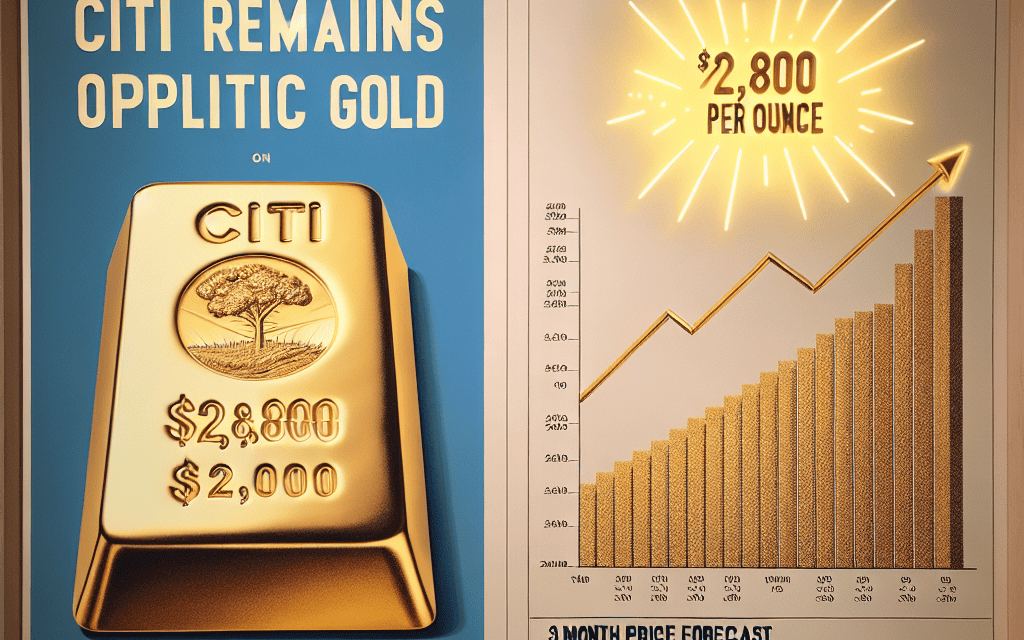“Golden Horizon: Citi’s Bullish Forecast Shines at $2,800 per Ounce”
Introduction
Citi has expressed a bullish outlook on gold, adjusting its three-month price forecast to $2,800 per ounce. This optimistic stance reflects the bank’s analysis of current market conditions, including economic uncertainties, inflationary pressures, and geopolitical tensions, which are driving investors towards safe-haven assets like gold. Citi’s revised forecast underscores the precious metal’s potential for significant appreciation in the near term, as it continues to attract interest from both institutional and retail investors seeking stability amidst global financial volatility.
Citi’s Bullish Outlook: Understanding the Factors Behind the $2,800 Gold Forecast
Citi’s recent decision to raise its three-month price forecast for gold to $2,800 per ounce reflects a confluence of factors that have bolstered the bank’s bullish outlook on the precious metal. This optimistic projection is rooted in a complex interplay of global economic conditions, investor behavior, and market dynamics that collectively suggest a favorable environment for gold appreciation. As we delve into the rationale behind Citi’s forecast, it becomes evident that several key elements are at play, each contributing to the anticipated rise in gold prices.
To begin with, the current global economic landscape is characterized by heightened uncertainty, which traditionally drives investors towards safe-haven assets like gold. Economic instability, exacerbated by geopolitical tensions and unpredictable policy shifts, has led to increased volatility in financial markets. In such times, gold is often perceived as a reliable store of value, offering protection against currency devaluation and inflationary pressures. Citi’s analysts have likely taken into account these macroeconomic factors, recognizing that the persistent uncertainty is likely to sustain strong demand for gold in the near term.
Moreover, the monetary policies of major central banks have played a significant role in shaping the outlook for gold. With interest rates remaining at historically low levels, the opportunity cost of holding non-yielding assets like gold diminishes, making it a more attractive investment option. Additionally, the expansive monetary policies adopted by central banks in response to economic challenges have led to concerns about potential inflationary pressures. Gold, traditionally seen as a hedge against inflation, stands to benefit from such apprehensions, further supporting Citi’s optimistic forecast.
In addition to these macroeconomic and monetary factors, investor sentiment and behavior have also contributed to the positive outlook for gold. The increasing interest in gold-backed exchange-traded funds (ETFs) and other investment vehicles indicates a growing appetite for exposure to the precious metal. This trend is driven by both institutional and retail investors seeking to diversify their portfolios and mitigate risks associated with other asset classes. Citi’s forecast likely reflects an expectation that this trend will continue, providing sustained support for gold prices.
Furthermore, the supply-side dynamics of the gold market cannot be overlooked. While demand for gold is expected to remain robust, the supply of newly mined gold is relatively inelastic, constrained by the long lead times and significant capital investments required for mining operations. This supply-demand imbalance is likely to exert upward pressure on gold prices, aligning with Citi’s projection of a price increase.
In conclusion, Citi’s decision to raise its three-month price forecast for gold to $2,800 per ounce is underpinned by a comprehensive analysis of various factors influencing the gold market. The interplay of global economic uncertainty, accommodative monetary policies, investor behavior, and supply-side constraints collectively create a conducive environment for gold appreciation. As these elements continue to unfold, Citi’s bullish outlook on gold appears well-founded, offering valuable insights into the potential trajectory of this precious metal in the coming months.
Market Reactions: How Investors Are Responding to Citi’s Gold Price Prediction
Citi’s recent upward revision of its three-month gold price forecast to $2,800 per ounce has sparked significant interest and varied reactions among investors. This optimistic outlook comes at a time when global economic uncertainties and geopolitical tensions are influencing market dynamics, prompting investors to reassess their portfolios. As gold is traditionally viewed as a safe-haven asset, Citi’s prediction has led to a flurry of activity in the commodities market, with investors keenly observing the potential implications of such a price surge.
In the wake of Citi’s announcement, many investors are re-evaluating their strategies, considering the potential benefits of increasing their exposure to gold. The bank’s forecast suggests a bullish sentiment towards the precious metal, driven by factors such as inflationary pressures, currency fluctuations, and ongoing geopolitical instability. These elements collectively contribute to a favorable environment for gold, as it is often perceived as a hedge against inflation and currency devaluation. Consequently, investors who prioritize risk management are likely to view Citi’s prediction as a compelling reason to bolster their gold holdings.
Moreover, the anticipation of higher gold prices has also influenced the behavior of institutional investors. Hedge funds and asset managers, in particular, are closely monitoring the situation, as a significant rise in gold prices could impact their investment strategies and portfolio allocations. For these entities, the potential for substantial returns on gold investments may outweigh the risks associated with other asset classes, especially in a volatile market environment. As a result, some institutional investors are already adjusting their positions, increasing their stakes in gold-related assets such as mining stocks and exchange-traded funds (ETFs).
On the other hand, not all market participants share Citi’s optimistic outlook. Some analysts and investors remain cautious, pointing to potential headwinds that could temper gold’s ascent. For instance, the possibility of interest rate hikes by central banks could strengthen currencies like the US dollar, thereby exerting downward pressure on gold prices. Additionally, any resolution of geopolitical tensions or improvements in global economic conditions could reduce the demand for safe-haven assets, leading to a potential correction in gold prices. These considerations highlight the complexity of the market and the need for investors to remain vigilant and adaptable in their strategies.
Furthermore, the broader market reaction to Citi’s forecast underscores the diverse perspectives within the investment community. While some investors are eager to capitalize on the potential upside, others are adopting a more conservative approach, opting to wait for further confirmation of the predicted price movement. This divergence in sentiment reflects the inherent uncertainty in financial markets, where predictions and forecasts are subject to a myriad of influencing factors.
In conclusion, Citi’s revised gold price forecast has undoubtedly captured the attention of investors, prompting a range of responses that reflect the multifaceted nature of the market. As investors navigate this evolving landscape, they must weigh the potential rewards against the associated risks, considering both the macroeconomic environment and their individual investment objectives. Ultimately, the coming months will reveal whether Citi’s optimism is well-founded, as market participants continue to monitor developments and adjust their strategies accordingly.
Economic Indicators: What Is Driving Citi’s Optimism in Gold Prices?
Citi’s recent upward revision of its three-month gold price forecast to $2,800 per ounce reflects a confluence of economic indicators and market dynamics that have bolstered the bank’s optimism. This adjustment is not merely a reaction to short-term market fluctuations but rather a strategic response to a series of underlying factors that are shaping the global economic landscape. As investors seek safe havens amid economic uncertainty, gold’s allure as a stable asset has been magnified, prompting financial institutions like Citi to reassess their projections.
One of the primary drivers of Citi’s optimism is the persistent volatility in global financial markets. With geopolitical tensions escalating in various regions and the ongoing repercussions of the COVID-19 pandemic, investors are increasingly turning to gold as a hedge against uncertainty. The metal’s historical role as a store of value during turbulent times has been reinforced, leading to heightened demand and, consequently, upward pressure on prices. Furthermore, the fluctuating performance of major currencies, particularly the U.S. dollar, has also played a significant role. As the dollar weakens, gold becomes more attractive to investors holding other currencies, further driving up demand.
In addition to these factors, inflationary pressures have emerged as a critical consideration in Citi’s revised forecast. Central banks around the world have implemented expansive monetary policies to stimulate economic recovery, resulting in increased money supply and, in some cases, rising inflation rates. Gold, traditionally viewed as a hedge against inflation, has benefited from these conditions. Investors are seeking to preserve their purchasing power in the face of potential currency devaluation, thereby increasing their allocation to gold.
Moreover, the interest rate environment has been conducive to higher gold prices. With central banks maintaining low interest rates to support economic growth, the opportunity cost of holding non-yielding assets like gold diminishes. This scenario encourages investors to diversify their portfolios with gold, which, despite not offering interest or dividends, provides security and stability. Citi’s forecast takes into account the likelihood of continued low interest rates, which are expected to persist as economies navigate the path to recovery.
Another aspect contributing to Citi’s positive outlook is the robust demand from emerging markets, particularly in Asia. Countries like China and India, which have a cultural affinity for gold, continue to exhibit strong demand for the metal, both for investment and jewelry purposes. As these economies recover and grow, their consumption of gold is anticipated to rise, providing further support to global prices.
Citi’s forecast also considers the supply side of the equation. Gold production has faced challenges due to environmental regulations, rising production costs, and geopolitical issues affecting mining operations. These constraints on supply, coupled with increasing demand, create a favorable environment for higher gold prices.
In conclusion, Citi’s decision to raise its three-month gold price forecast to $2,800 per ounce is underpinned by a comprehensive analysis of economic indicators and market trends. The interplay of geopolitical tensions, currency fluctuations, inflationary pressures, interest rate dynamics, and demand from emerging markets all contribute to a bullish outlook for gold. As these factors continue to evolve, Citi remains confident in gold’s potential to serve as a reliable asset in uncertain times, offering investors a measure of security and stability in an ever-changing economic landscape.
Historical Context: Comparing Citi’s Forecast with Past Gold Price Trends
Citi’s recent decision to raise its three-month price forecast for gold to $2,800 per ounce has captured the attention of investors and analysts alike. This optimistic outlook is not only a reflection of current market dynamics but also a continuation of historical trends that have seen gold prices fluctuate in response to various economic and geopolitical factors. To understand the significance of Citi’s forecast, it is essential to examine past gold price trends and the factors that have historically influenced these movements.
Historically, gold has been regarded as a safe-haven asset, particularly during times of economic uncertainty and geopolitical tension. This perception has led to significant price increases during periods of financial instability. For instance, during the 2008 financial crisis, gold prices surged as investors sought refuge from volatile stock markets and declining currencies. Similarly, in the early 1980s, gold prices reached unprecedented levels in response to high inflation and geopolitical tensions, such as the Iranian Revolution and the Soviet invasion of Afghanistan.
In more recent years, gold prices have continued to be influenced by a combination of economic indicators, including interest rates, inflation, and currency fluctuations. The COVID-19 pandemic, for example, led to a surge in gold prices as central banks around the world implemented aggressive monetary policies to support their economies. This environment of low interest rates and increased money supply made gold an attractive investment, driving prices to record highs in 2020.
Citi’s current forecast of $2,800 per ounce reflects a belief that similar conditions may persist in the near term. The bank’s analysts point to several factors that could support higher gold prices, including ongoing geopolitical tensions, potential economic slowdowns, and the possibility of continued accommodative monetary policies by central banks. Furthermore, the recent volatility in global financial markets has underscored the importance of diversification, prompting investors to consider gold as a hedge against potential risks.
Comparing Citi’s forecast with past trends, it is evident that the bank’s optimism is not without precedent. Historically, gold prices have demonstrated a tendency to rise during periods of uncertainty, and the current global landscape presents several challenges that could drive demand for the precious metal. Additionally, the potential for inflationary pressures, driven by supply chain disruptions and increased government spending, may further bolster gold’s appeal as an inflation hedge.
While Citi’s forecast is undoubtedly optimistic, it is important to recognize that gold prices are subject to a myriad of influences, and predicting future movements is inherently challenging. Factors such as changes in investor sentiment, shifts in monetary policy, and unexpected geopolitical developments can all impact gold prices in unpredictable ways. Nevertheless, Citi’s analysis provides valuable insight into the potential trajectory of gold prices in the coming months.
In conclusion, Citi’s decision to raise its three-month price forecast for gold to $2,800 per ounce is grounded in a historical understanding of the factors that have traditionally influenced gold prices. By examining past trends and considering current market conditions, Citi’s analysts have identified several key drivers that could support higher gold prices in the near term. As investors navigate an increasingly complex global landscape, gold’s role as a safe-haven asset remains as relevant as ever, offering a potential refuge from economic and geopolitical uncertainties.
Investment Strategies: How to Position Your Portfolio in Light of Citi’s Gold Forecast
Citi’s recent upward revision of its three-month gold price forecast to $2,800 per ounce has captured the attention of investors worldwide, prompting a reevaluation of portfolio strategies. This optimistic outlook on gold is driven by a confluence of factors, including economic uncertainties, geopolitical tensions, and inflationary pressures, which collectively enhance gold’s appeal as a safe-haven asset. As investors seek to navigate these turbulent times, understanding how to position one’s portfolio in light of Citi’s forecast becomes crucial.
To begin with, gold has historically been perceived as a hedge against inflation and currency devaluation. In the current economic climate, characterized by rising inflation rates and volatile currency markets, gold’s intrinsic value becomes increasingly attractive. Investors looking to safeguard their portfolios against these risks may consider increasing their allocation to gold. This can be achieved through direct investment in physical gold, such as bullion or coins, or through financial instruments like gold exchange-traded funds (ETFs) and gold mining stocks. Each option offers distinct advantages and risks, and investors should carefully assess their risk tolerance and investment goals before making a decision.
Moreover, Citi’s bullish stance on gold is also influenced by ongoing geopolitical tensions, which have historically driven demand for safe-haven assets. In times of political instability or conflict, gold often experiences a surge in demand as investors seek refuge from the uncertainties of global markets. Therefore, incorporating gold into a diversified portfolio can provide a buffer against geopolitical risks, offering a measure of stability in an otherwise unpredictable environment.
In addition to these considerations, the current low-interest-rate environment further supports the case for gold investment. With central banks around the world maintaining accommodative monetary policies to stimulate economic growth, real interest rates remain low or even negative. This scenario diminishes the opportunity cost of holding non-yielding assets like gold, making it a more attractive option for investors seeking to preserve capital. Consequently, adjusting portfolio allocations to include a higher proportion of gold can be a prudent strategy in the face of prolonged low-interest rates.
However, it is essential for investors to approach gold investment with a balanced perspective. While Citi’s forecast presents a compelling case for gold, it is important to recognize that all investments carry inherent risks. Gold prices can be volatile, influenced by factors such as changes in investor sentiment, shifts in monetary policy, and fluctuations in the global economy. Therefore, diversification remains a key principle in portfolio management. By maintaining a well-diversified portfolio that includes a mix of asset classes, investors can mitigate the risks associated with any single investment, including gold.
In conclusion, Citi’s optimistic forecast for gold presents a timely opportunity for investors to reassess their portfolio strategies. By considering the role of gold as a hedge against inflation, a safeguard against geopolitical risks, and a beneficiary of the low-interest-rate environment, investors can make informed decisions about their asset allocations. While the allure of gold is undeniable, it is crucial to balance enthusiasm with caution, ensuring that investment decisions align with individual risk profiles and long-term financial objectives. As the global economic landscape continues to evolve, staying informed and adaptable will be key to successfully navigating the complexities of the investment world.
Global Implications: The Impact of Rising Gold Prices on International Markets
Citi’s recent decision to raise its three-month price forecast for gold to $2,800 per ounce has sparked considerable interest and speculation across international markets. This optimistic outlook reflects a confluence of factors that are driving the precious metal’s value upward, with significant implications for global economies. As investors and policymakers alike grapple with the potential consequences, it is crucial to understand the underlying dynamics and the broader impact of rising gold prices on international markets.
To begin with, gold has long been considered a safe-haven asset, particularly during times of economic uncertainty. The current global economic landscape, characterized by geopolitical tensions, inflationary pressures, and fluctuating currency values, has heightened the appeal of gold as a stable store of value. Citi’s revised forecast underscores the growing demand for gold as investors seek to hedge against these uncertainties. This increased demand is not only a reflection of individual investor behavior but also indicative of broader market trends that are shaping the global financial system.
Moreover, the implications of rising gold prices extend beyond individual investors to affect central banks and national economies. Many central banks hold significant reserves of gold, and an increase in its price can bolster their balance sheets, providing a buffer against economic volatility. This, in turn, can influence monetary policy decisions, as central banks may adjust interest rates or engage in other measures to stabilize their economies in response to changing gold valuations. Consequently, the ripple effects of Citi’s forecast are likely to be felt across various sectors, influencing everything from currency exchange rates to international trade dynamics.
In addition to its impact on central banks, the rise in gold prices also has significant implications for countries that are major producers of the metal. Nations such as China, Russia, and Australia, which are among the world’s largest gold producers, stand to benefit from increased revenues as prices climb. This can lead to enhanced economic growth and development opportunities within these countries, as higher gold prices can stimulate investment in mining infrastructure and related industries. However, it is important to note that the benefits may not be evenly distributed, as fluctuations in gold prices can also lead to increased volatility in commodity-dependent economies.
Furthermore, the impact of rising gold prices is not limited to producing countries; it also affects nations that are major consumers of gold, such as India and China. In these countries, gold is not only a financial asset but also holds cultural and traditional significance. As prices rise, consumer demand may be affected, potentially leading to shifts in purchasing behavior and impacting related industries, such as jewelry manufacturing and retail.
In conclusion, Citi’s optimistic forecast for gold prices highlights the complex interplay of factors influencing the global economy. As gold continues to be a critical component of financial markets, its rising value has far-reaching implications for international markets. From influencing central bank policies to affecting the economies of producing and consuming nations, the impact of rising gold prices is multifaceted and significant. As such, investors, policymakers, and market participants must remain vigilant and adaptive to navigate the evolving landscape shaped by these developments. The coming months will undoubtedly reveal more about the trajectory of gold prices and their broader economic consequences, making it an area of keen interest and scrutiny for all stakeholders involved.
Risk Assessment: Evaluating the Potential Challenges to Citi’s Gold Price Forecast
Citi’s recent decision to raise its three-month gold price forecast to $2,800 per ounce has captured the attention of investors and analysts alike. This optimistic outlook reflects a confluence of factors that Citi believes will drive gold prices higher in the near term. However, as with any forecast, it is essential to evaluate the potential challenges that could impact this projection. Understanding these risks is crucial for investors who are considering gold as part of their portfolio strategy.
To begin with, one of the primary drivers behind Citi’s bullish stance on gold is the current macroeconomic environment. With persistent inflationary pressures and geopolitical uncertainties, gold is traditionally seen as a safe-haven asset. Investors often flock to gold during times of economic instability, seeking to preserve their wealth. However, it is important to consider that the global economic landscape is highly dynamic. Any unexpected shifts, such as a sudden resolution to geopolitical tensions or a more aggressive monetary policy stance by central banks, could alter investor sentiment and impact gold prices.
Moreover, the strength of the U.S. dollar plays a significant role in determining gold prices. Typically, gold and the dollar have an inverse relationship; when the dollar strengthens, gold prices tend to weaken, and vice versa. Citi’s forecast assumes a relatively stable or weakening dollar, which would support higher gold prices. However, should the dollar experience a resurgence due to factors such as stronger-than-expected economic data or a shift in Federal Reserve policy, this could pose a challenge to Citi’s optimistic forecast.
In addition to currency fluctuations, interest rates are another critical factor to consider. Gold is a non-yielding asset, meaning it does not generate income like bonds or dividend-paying stocks. As a result, when interest rates rise, the opportunity cost of holding gold increases, potentially leading to a decrease in demand. Citi’s forecast likely assumes a continuation of the current low-interest-rate environment. However, if inflationary pressures force central banks to raise interest rates more aggressively than anticipated, this could dampen the appeal of gold and challenge the forecasted price increase.
Furthermore, the supply and demand dynamics within the gold market itself cannot be overlooked. On the supply side, any significant increase in gold production or new discoveries could exert downward pressure on prices. Conversely, on the demand side, changes in consumer behavior, particularly in key markets such as India and China, could influence gold’s trajectory. For instance, if economic conditions in these countries improve, leading to increased consumer spending on gold jewelry and investments, this could support higher prices. However, any economic slowdown or changes in consumer preferences could pose a risk to Citi’s forecast.
Lastly, it is essential to consider the potential impact of speculative trading and market sentiment. Gold markets can be highly volatile, with prices often influenced by speculative activities and investor psychology. Sudden shifts in sentiment, driven by factors such as market rumors or unexpected economic data releases, can lead to rapid price fluctuations. While Citi’s forecast is based on a thorough analysis of current conditions, the inherent unpredictability of market sentiment remains a challenge.
In conclusion, while Citi’s optimistic forecast for gold prices is grounded in a comprehensive assessment of current economic and market conditions, several potential challenges could impact this projection. Investors should remain vigilant and consider these risks when evaluating their investment strategies. By staying informed and adaptable, they can better navigate the complexities of the gold market and make informed decisions that align with their financial goals.
Q&A
1. **What is Citi’s new 3-month price forecast for gold?**
Citi has raised its 3-month price forecast for gold to $2,800 per ounce.
2. **Why is Citi optimistic about gold prices?**
Citi is optimistic due to factors such as economic uncertainty, inflation concerns, and potential monetary policy shifts that could drive demand for gold as a safe-haven asset.
3. **What was the previous 3-month price forecast for gold by Citi?**
The previous forecast was lower than $2,800 per ounce, though the exact figure is not specified.
4. **How does economic uncertainty affect gold prices?**
Economic uncertainty often leads investors to seek safe-haven assets like gold, increasing demand and driving up prices.
5. **What role does inflation play in Citi’s gold price forecast?**
Inflation concerns can lead to higher gold prices as investors look to hedge against the eroding purchasing power of fiat currencies.
6. **How might monetary policy shifts impact gold prices according to Citi?**
Potential shifts towards more accommodative monetary policies could weaken currencies and boost gold prices as an alternative store of value.
7. **What is the significance of gold as a safe-haven asset?**
Gold is considered a safe-haven asset because it tends to retain value or appreciate during times of economic instability, making it attractive to investors seeking to protect their wealth.
Conclusion
Citi’s optimistic outlook on gold, reflected in its revised three-month price forecast of $2,800 per ounce, underscores a strong belief in the metal’s potential as a safe-haven asset amid global economic uncertainties. This bullish stance likely considers factors such as inflationary pressures, geopolitical tensions, and potential shifts in monetary policy, which could drive increased demand for gold. Citi’s forecast suggests confidence in gold’s ability to retain and potentially increase its value, appealing to investors seeking stability and protection against market volatility.





